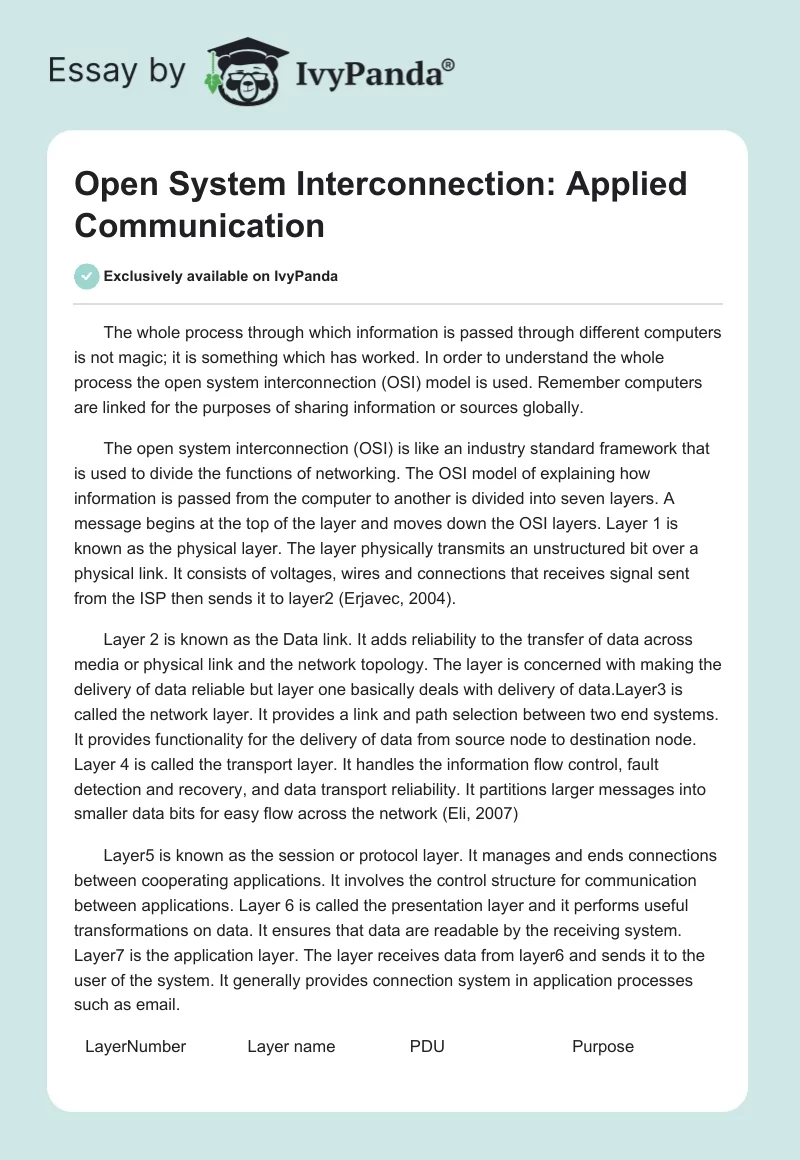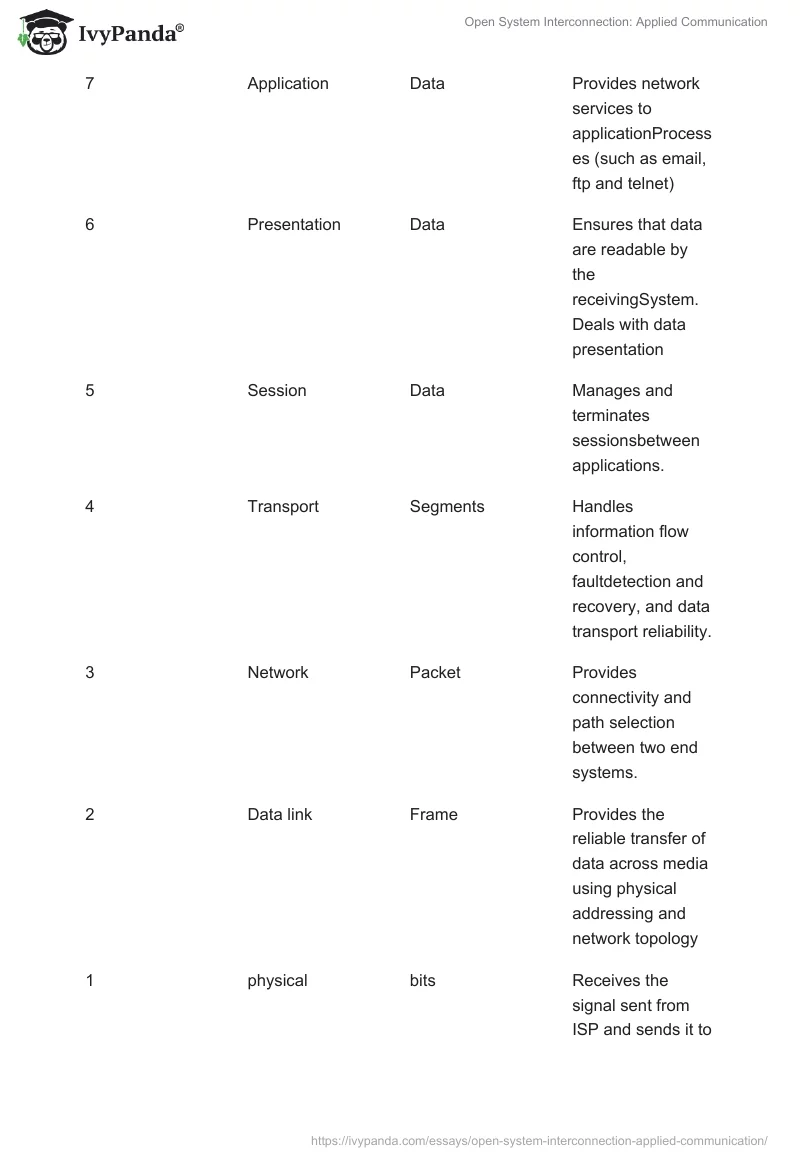The whole process through which information is passed through different computers is not magic; it is something which has worked. In order to understand the whole process the open system interconnection (OSI) model is used. Remember computers are linked for the purposes of sharing information or sources globally.
The open system interconnection (OSI) is like an industry standard framework that is used to divide the functions of networking. The OSI model of explaining how information is passed from the computer to another is divided into seven layers. A message begins at the top of the layer and moves down the OSI layers. Layer 1 is known as the physical layer. The layer physically transmits an unstructured bit over a physical link. It consists of voltages, wires and connections that receives signal sent from the ISP then sends it to layer2 (Erjavec, 2004).
Layer 2 is known as the Data link. It adds reliability to the transfer of data across media or physical link and the network topology. The layer is concerned with making the delivery of data reliable but layer one basically deals with delivery of data.Layer3 is called the network layer. It provides a link and path selection between two end systems. It provides functionality for the delivery of data from source node to destination node. Layer 4 is called the transport layer. It handles the information flow control, fault detection and recovery, and data transport reliability. It partitions larger messages into smaller data bits for easy flow across the network (Eli, 2007)
Layer5 is known as the session or protocol layer. It manages and ends connections between cooperating applications. It involves the control structure for communication between applications. Layer 6 is called the presentation layer and it performs useful transformations on data. It ensures that data are readable by the receiving system. Layer7 is the application layer. The layer receives data from layer6 and sends it to the user of the system. It generally provides connection system in application processes such as email.
Source: Self
The term multiplexing refers to the process of merging multiple communication paths into a single signal path. It is used in the wireless and landline telecommunication industry. The path is created by connecting each module or system which collects, calculates exchange or display data to a single serial communication bus. The advantage of multiplexing is that it allows the transmission of multiple communications over a single line. There are two methods of multiplexing namely: frequency division and time division multiplexing. Frequency division multiplexing in communication system is a way of enabling separation between channels so that several messages can be handled by the same circuit at the same time, each message being transmitted at a different frequency. It is a scheme in which numerous signals are combined for transmission on a single communications line. Each input signal is sent and received at maximum speed all the time. However, if many signals must be sent along a single long distance line, the necessary bandwidth should be large and a careful engineering is required to ensure that the system performs properly. FDM uses a common transmission path, but each signal is modulated onto different carrier frequency and switching is achieved by providing each outlet with a demodulation which can have its carrier frequency achieved. This is used to increase the tratic capacity of the satellite by making all carrier frequencies available to all ground.
Time division multiplexing (TMD) is a method of putting multiple data streams in a single signal by separating the signal into many segments, each having a very short duration. Each individual data stream is reassembled at the receiving end based on the timing. The circuit that combines signals at the source end of a communication link is known as a multiplex. It accepts the input from each individual end user breaks each signal into segments and assigns the segments. The segments are assigned to the composite signal in arotating and repeating sequence. If many signals must be sent along a single long distance line, then careful engineering is required in order to ensure that the system functions properly. An asset of time division multiplexing is its flexibility. The scheme allows for variation in the number of signals being sent along the line, and constantly adjusts the time intervals to make optimum use of the available bandwidth. More compactly, multiplexing in modern communication system enables many paths of communications into a single path. For example in a DVD player, it basically means that DVD is translating the files into a proper DVD format (Mark, 2001).
Internet 2 is a joint project by over 120 research universities working with partners in industry and government, to develop a new family of advanced applications to meet emerging academic requirements in research, teaching and learning. This group came together to address the following challenges facing the next generation of university networking performance. The most important one is creating and sustaining a leading edge network capability for the national research community, second one is to direct network development efforts to enable the new generation of applications to fully exploit the capabilities of broadband networks, and lastly they wanted to fasten the transfer of new network services and applications to all levels of education use and to the entire internet community both nationally and internationally. The objectives of coming up with internet 2 was developed when researchers and academicians found out that the current internet lacks applications and capability to process and access very large complex data. This was to help the new generation full of knowledge to exploit all the opportunities across the world because it was found to be a way of building better connectivity as a means of accessing applications and reaching other sites (Guang, 2006).
Protocols such as TCP normally provide a reliable end –to –end delivery by helping in recovery from network errors but are also inadequate in real time applications such as voice, remote imaging or time sensitive data collection system which require quality of services and minimization of loss. Such application cannot be performed by commodity internet (Donald & Derek, 1963).
Internet 2 is deploying and developing advanced network applications and technologies for research and higher education acceleration of the creation of tomorrow’s internet. The advanced networks include the Abilene and middleware. Abilene is referred to as an advanced backbone network that supports the development and deployment of the new applications being developed within the internet 2 community. It connects regional network aggregation points. The middleware is a layer of software between the network and the applications. It provides services such as identification, authentication, authorization and security. Nowadays internet applications usually have to provide these services themselves which will lead to high standards. While internet1 is open to mostly anyone with a computer, access to internet 2 is limited to a few and its backbone is made up of entirely of large capacity fiber-optic cables. Therefore internet 2 is expected to speed up the rate of moving the data for example at 10 gigabits per second or more Alexendrar Russo (2005). This internet was therefore targeting higher education and teacher educations preferably at the university level (Richard, 1997).
Although update internet2 is available to a limited number of institutions it is expected that the technology will be available to everyone in the near future where it is to enhance the possibility of enabling collaboration between united States and other countries around the world. A zigbee (802, 15.4) is the name of a specification set of high standard or level communication protocols designed to use small, low power digital radios based on the IEE 802. 15.4 standards for wireless personal area networks. It was developed with an aim of enabling reliable, cost effective, low power and wirelessly networked monitoring and control products based on an open global standard. The targeted produce and application of Zigbee (802.15.4) are medical monitoring, home industrial and building automation or control.
A Bluetooth (802.15.1) system operates in the 2.4 GHZ unlicensed band. It uses a lot of power and the protocols are too complex therefore too expensive to be embedded in virtually every kind of device imaginable. It uses spreads-spectrum technologies with each device, when transmitting hopping pseudo-randomly in frequency at a 1600 hops/sec rate. The modulation used is binary Gaussian-shaped frequency-shift keying (GFSK). The Bluetooth wireless technology is set to revolutionize the personal connectivity market by providing freedom from wired connections for portable handled devices. A Wi-Fi (802.11b/aig) system is also referred to as the IEEE802.11. It is a term for certain types of wireless local area networks (WLAN) that use specifications conforming to IEE 802 11b. It has been used in areas such as airports and hotels where people can access Wi-Fi networks to access internet and receive emails on the move. The locations are known as the hotspots. The Wi-Fi uses low power microwave radio to link one or more groups of users together or link between two buildings. It can span several kilometers point to point but cannot be used where trees are on the way. Therefore, Wi-Fi uses wireless local area network that uses highfrequecy radio signals and since it is a wireless then it is capable of transmitting the data to the 3G or third generation and T-mobile.
References
- Clifford L. (1999) Information about internet 2 Mc Graw- Hill Publishers New York
- Donald W. & Derek H (1963) Communication Networks for Computers.Amazon.com Publishers. London
- Elinet, S. (2000) Wireless Telcom Faq S M Graw Hill Professional Publisher. Newyork
- Eli N. (2007) Absolute beginners Guide to Networking. 4th Ed Safari Books Publishers UK
- Erjavec, S. (2004) Automotive Technology: A System Approach. Thomson Delmar Publishers Newyork
- Guang Z (2006) Body Sensor Networks.Mc Graw-Hill Publishers New York
- Mark L. (2002) Firewall Policies and VPN Configuration. Amazon. Com Publishers London
- Mark, P. (2001) what is the Matter with Internet: A critical theory of Cyber-space. University of Minnesota press.
- Richard V. (1997). Motor Control Electronics. Mc Graw Hill Professional Publishers London.
- Robern, B. (2003) Electronic Measurement and Instrumentation. Safari Books publishers UK


